Abstract
Electronic publishing is being influenced by the increasing complexity and reach of information and by a rapidly growing user population. Because of these developments, average authors of electronically published documents have little expert knowledge about how to create well-designed charts. Authors are also confronted with considerable individual differences among remote recipients in culture, social life, education, psychology and physiology. In order to compensate for these differences it is necessary to integrate the interpretation and interaction abilities of individual users into future editing and presentation systems. We are developing a chart editing and presentation system which generates critiques and suggestions for authors and recipients on request. These critiques are based on individual user models and on expert knowledge in chart editing. Critiques are generated on user request depending on the state of a chart. The system helps authors to avoid commonly made mistakes. It empowers recipients to adapt chart parameters (e.g., colors, font size) to their individual abilities, disabilities and preferences.
We would like to thank all participants in the user tests, Dr. Tauber and the senior-project group for implementing the chart editor, and the multimedia research group at C-LAB for valuable input. C-LAB is the Joint R&D Institute of Paderborn University and Siemens Nixdorf Information Systems.
Access this chapter
Tax calculation will be finalised at checkout
Purchases are for personal use only
Preview
Unable to display preview. Download preview PDF.
References
Bergman, L. D., Rogowitz, B. E., and Treinish L. A. (1995). A rule-based tool for assisting colormap selection. In Proceedings of IEEE Visualization ’95, 118–125.
Dietrich, H., Malinowski, U., Kühme, T., and Schneider-Hufschmidt, M. (1993). State of the art in adaptive user interfaces. In Adaptive User Interfaces: Principles and Practice, Amsterdam: Elsevier Science Publishers.
di Primio, Franco (1995). Methoden der künstlichen Intelligenz für Grafikanwendungen. Addison-Wesley.
Domik, G. O., and Gutkauf, B. (1994). User modeling for adaptive visualization systems. In Proceedings of IEEE Visualization ’94, 217–223.
Fischer, G., Mastaglio, T., Reeves, B., and Rieman, J. (1990). Minimalist explanations in knowledge-based systems. In Proceedings of the 23rd Annual International Conference on Systems Sciences.
Foley, D., and van Dam, A. (1990). Computer Graphics. Addison-Wesley.
Gutkauf, B. (1994). User Modeling in Scientific Visualization. Graduate Thesis, Department of Computer Science, University of Colorado, Boulder, CO.
Höök, K., Karlgren, J., and Wærn, A. (1995). A glass-box intelligent help interface. In Proceedings of the First International Workshop on Intelligence and Multimodality in Multimedia Interfaces.
Higgins, K. E. (1975). The Logic of Color Vision Testing. A Primer.
Hunt, R.W. (1987). Measuring Color. Chichester, England: Ellis Horwood.
Kansy, K., and Wißkirchen, P. (1988). Graphiken im Bürobereich. Springer.
Mumford, A. M. (1991). Scientific Visualization—Techniques and Applications. Springer.
Rudisill, M., Lewis, C., Poison, P. B., and McKay, T. D. (1996). Human-Computer Interface Design. San Francisco, CA: Morgan Kaufmann.
Senay, H., and Ignatius, E. (1994). A knowledge-based system for visualization design. In IEEE Computer Graphics and Applications 14:36–47.
Shepard, R.N., and Metzler, J. (1971). Mental rotation of three dimensional objects. Science, 171:701–703.
Software Technology Branch. (1995). Clips Reference Manual. Lyndon B. Johnson Space Center, (http://www.jsc.nasa.gov/~clips)
Thies, S. (1977). Ein benutzeradaptives Kritiksystem für Grafiken modelliert durch eine Regelsprache. Ph.D. Dissertation, Department of Computer Science, Paderborn University, Germany. In preparation.
Zelanzy, G. (1986). Wie aus Zahlen Bilder werden. Wiesbaden: Gabler Verlag.
Author information
Authors and Affiliations
Editor information
Editors and Affiliations
Rights and permissions
Copyright information
© 1997 Springer-Verlag Wien
About this paper
Cite this paper
Gutkauf, B., Thies, S., Domik, G. (1997). A User-Adaptive Chart Editing System Based on User Modeling and Critiquing. In: Jameson, A., Paris, C., Tasso, C. (eds) User Modeling. International Centre for Mechanical Sciences, vol 383. Springer, Vienna. https://doi.org/10.1007/978-3-7091-2670-7_18
Download citation
DOI: https://doi.org/10.1007/978-3-7091-2670-7_18
Publisher Name: Springer, Vienna
Print ISBN: 978-3-211-82906-6
Online ISBN: 978-3-7091-2670-7
eBook Packages: Springer Book Archive

